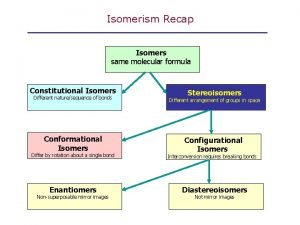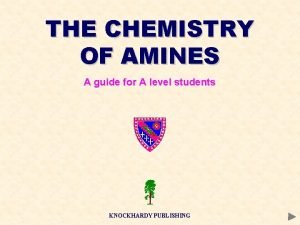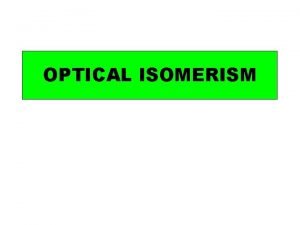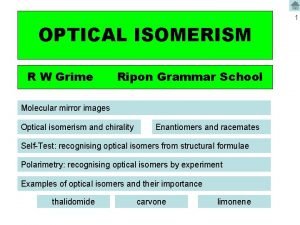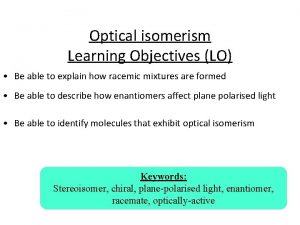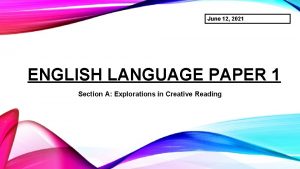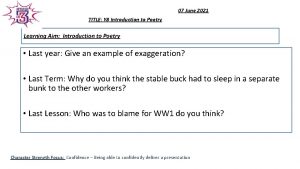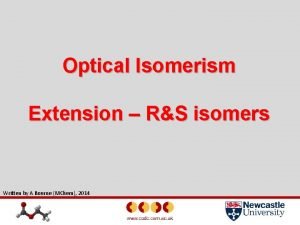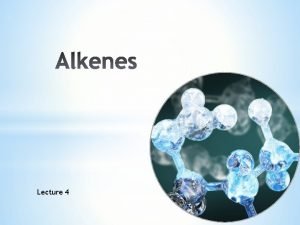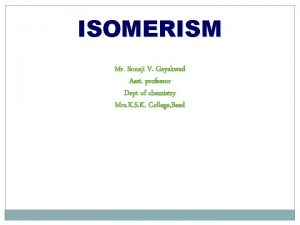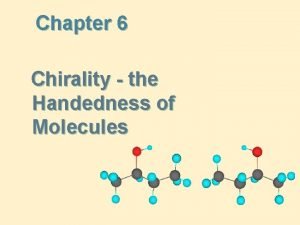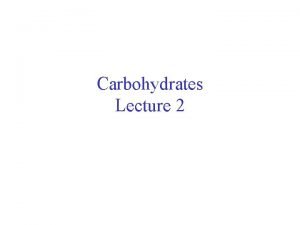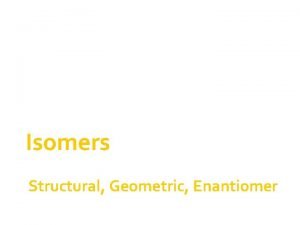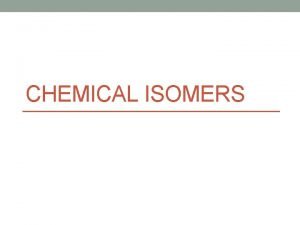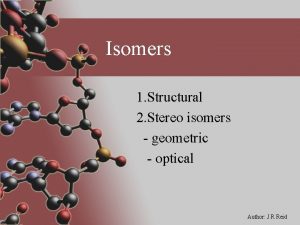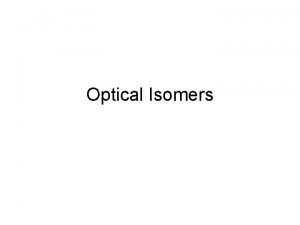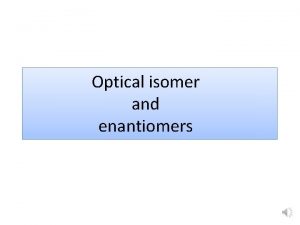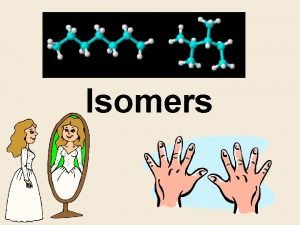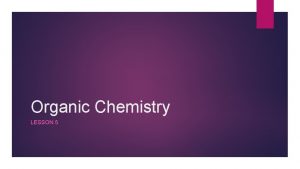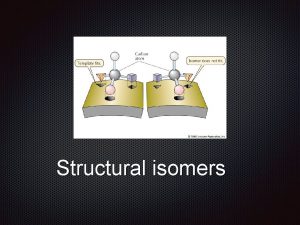Optical Isomers And Mechanisms 03 June 2021 Optical














- Slides: 14

Optical Isomers And Mechanisms 03 June 2021

Optical Isomers And Mechanisms • Understand the nature of a racemic mixture • Be able to use data on optical activity of reactants and products as evidence for SN 1 and SN 2 mechanisms

SN 1 and SN 2 Mechanisms Some information from Kinetics II. The rate determining step is the slowest step in a multistep reaction. SN 1 is a nucleophilic substitution reaction that only involves 1 molecule or ion in the rate determining step SN 2 is a nucleophilic substitution reaction that involves 2 molecules, 1 molecule and 1 ion or 2 ions in the rate determining step

SN 1 and SN 2 Mechanisms Optical activity can give you some insight into how the mechanism of a reaction works. For example nucleophilic reactions can take place by one of two mechanisms. If you know the optical activity of the reactant and the product you can sometimes work out the mechanism.

SN 1 Mechanism If it’s an SN 1 mechanism and you start with a single enantiomer reactant your product will be a racemic mixture of two optical isomers of each other. This means that it won’t rotate plane polarised light. Step 1: a group breaks off, leaving a planar (flat) ion Step 2: the planar ion can be attacked by a nucleophile from either side – this results in two optical isomers

SN 2 Mechanism In an SN 2 mechanism, a single enantiomer reactant produces a single enantiomer product. There’s only one step in this mechanism – the nucleophile always attacks the opposite side to the leaving group, so only one product is produced. The product will rotate plane – polarised light differently to the reactant.

Questions The molecule 2 -bromobutane displays optical isomerism. a) Draw the structure of 2 -bromobutane, and mark the chiral centre of the molecule on the diagram (1 mark) *

Questions The molecule 2 -bromobutane displays optical isomerism. A sample of a single, pure optical isomer of 2 -bromobutane is dissolved in an ethanol and water solvent and mixed with dilute sodium hydroxide solution. This mixture is gently heated under reflux and a substitution reaction occurs. The product of the reaction is a racemic mixture of butan-2 -ol. b) Explain why the butan-2 -ol solution produced will not rotate plane polarised light (1 mark) Since the butan-2 -ol solution is a racemic mixture, it must contain equal amounts of both optical isomers. The two optical isomers will exactly cancel out each other’s light-rotating effect [1 mark]

Questions The molecule 2 -bromobutane displays optical isomerism. A sample of a single, pure optical isomer of 2 -bromobutane is dissolved in an ethanol and water solvent and mixed with dilute sodium hydroxide solution. This mixture is gently heated under reflux and a substitution reaction occurs. The product of the reaction is a racemic mixture of butan-2 -ol. C) Has the substitution reaction proceeded via an SN 1 mechanism or an SN 2 mechanism? Explain your answer. [2 marks] The reaction has proceeded via an SN 1 mechanism (1 mark) You know this because the original solution contained a single optical isomer, but the product is a racemic mixture (1 mixture)

Questions An optically active isomer of 2 -bromobutane reacts with hydroxide ions to form butan-2 -ol. Explain why this product is a racemic mixture. (2 marks) The reaction involves a planar carbocation intermediate in an S N 1 reaction mechanism. The hydroxide ion can attack from above and below.

Questions An optically active isomer of 2 -chloro – 2 – methylbutane reacts with hydroxide ions to form 2 – methylbutan-2 -ol. Why is this product optically active? (1 mark) A The reaction is nucleophilic substitution B 2 – chloro – 2 – methylbutane forms a carbocation intermediate C 2 – chloro – 2 – methylbutane forms a five bonded intermediate D 2 - chloro – 2 – methylbutane contains a chiral carbon atom

Questions Ethanal reacts with HCN, in the presence of cyanide ions from KCN, to form 2 -hydroxypropanenitrile. + HCN H | H–C– | H OH | C – CN | H a) Predict the shape and bond angle around the carbon atom in the carbonyl group in ethanol. (2 marks) (trigonal) planar (1 mark) 120 o (1 mark)

Questions Ethanal reacts with HCN, in the presence of cyanide ions from KCN, to form 2 -hydroxypropanenitrile. + HCN H | H–C– | H OH | C – CN | H b) Use your answer to part (a) to suggest how the cyanide ion, CN -, can approach the Cδ+ atom in the carbonyl group. (1 mark) It can approach from both sides / above and below (1 mark)

Questions Ethanal reacts with HCN, in the presence of cyanide ions from KCN, to form 2 -hydroxypropanenitrile. H OH + HCN | H–C– | H | C – CN | H c) Use your answer to part (b) to explain why a racemic mixture of 2 hydroxypropanenitrile forms. (2 marks) The optical isomer formed depends upon how the cyanide ion approached the electron – deficient /partially positively charged carbon atom (1 mark), there is an equal chance of this being on one side or the other (1 mark)
 Diastereomers
Diastereomers Amino acid optical isomers
Amino acid optical isomers 3-methylhexane isomers
3-methylhexane isomers Slidetodoc.com
Slidetodoc.com 2-chlorobutane optical isomers
2-chlorobutane optical isomers 3-methylhexane optical isomers
3-methylhexane optical isomers Propenenol
Propenenol English language paper 1 2021 june
English language paper 1 2021 june Summary period: june 2021 poem
Summary period: june 2021 poem R s isomers
R s isomers Structural vs geometric isomers
Structural vs geometric isomers Difference between structural and geometric isomers
Difference between structural and geometric isomers R vs s configuration
R vs s configuration L and d isomers
L and d isomers Structural isomers
Structural isomers
